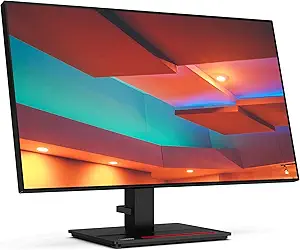In the ever-evolving world of monitors, Lenovo and Dell emerge as prominent contenders, each offering a diverse range of displays designed to cater to the needs of modern users. Whether you're a professional seeking precision, a gamer craving immersive visuals, or a casual user in need of reliability, choosing between Lenovo and Dell monitors can significantly impact your computing experience. Join us as we delve into the unique features and strengths of both brands, helping you navigate through the options and find the perfect monitor for your needs.
Key Features Comparison
Size
Dell and Lenovo both offer a wide range of monitor sizes to cater to different user needs. Dell monitors range from compact 19-inch models to large 49-inch ultrawide displays. Some of the latest offerings from Dell include the Dell Ultrasharp 49 Curved Monitor, which provides an immersive viewing experience with its expansive 49-inch screen size. On the other hand, Lenovo monitors range from 19.5 inches to 43.4 inches. The Lenovo ThinkVision P44w-10 is one of the largest monitors from Lenovo, offering a 43.4-inch display that provides ample screen real estate for multitasking. In terms of size, Dell monitors have an edge over Lenovo as they offer larger screens, which can be beneficial for professionals who require more screen space for their work. However, larger screens may not always be better as they can take up more desk space and may not be suitable for users with limited workspace. On the other hand, Lenovo monitors, while not offering as large screens as Dell, still provide a variety of sizes that can cater to different user needs. In comparison to other brands, both Dell and Lenovo offer competitive screen sizes, with Dell leading in the ultrawide monitor category.
Refresh Rate
Dell monitors are renowned for their high refresh rates, particularly in their gaming range. The Alienware AW3420DW, for example, boasts a refresh rate of 120Hz, which is currently one of the highest in the market. This high refresh rate ensures smooth, lag-free gaming and video playback, which is a significant advantage for gamers and video editors. However, some users have reported issues with ghosting, particularly in fast-paced games. Dell monitors also tend to be more expensive than their counterparts, which could be a downside for budget-conscious consumers. On the other hand, Lenovo monitors, such as the Legion Y44w-10, also offer high refresh rates, with this particular model offering a 144Hz refresh rate. This is slightly higher than the Dell model, providing an even smoother gaming experience. However, some users have reported that the color accuracy on Lenovo monitors is not as good as on Dell monitors, which could be a disadvantage for graphic designers and video editors. Lenovo monitors are generally more affordable than Dell monitors, making them a good option for those on a budget. However, their build quality is often reported to be less robust than that of Dell monitors.
Affordability
Dell and Lenovo are both reputable brands in the monitor market, each offering a range of products at different price points. Dell monitors are generally priced higher, but they also tend to offer more premium features. For instance, Dell's UltraSharp series, equipped with the latest technologies such as 4K resolution, HDR support, and USB-C connectivity, are priced higher due to their advanced features and superior performance. However, Dell also offers budget-friendly options like their SE series that provide decent performance at a lower cost. On the other hand, Lenovo monitors are typically more affordable and offer good value for money. Their ThinkVision series, for example, provides excellent picture quality and ergonomic design at a competitive price point. However, while Lenovo monitors are generally cheaper, they may not offer the same level of advanced features or premium build quality as some of the high-end Dell monitors. Nevertheless, Lenovo has been making strides in incorporating more advanced technologies in their monitors, making them a viable option for users on a budget. Compared to other brands, both Dell and Lenovo offer competitive pricing, with Dell leaning towards the higher end of the spectrum and Lenovo towards the lower end.
Reputation
Dell Monitors and Lenovo Monitors both have a reputable standing in the market, each with their unique strengths and weaknesses. Dell, a long-standing giant in the technology industry, has consistently produced high-quality monitors that are known for their durability, excellent performance, and innovative features. They have a wide range of monitors suitable for different needs, from gaming to professional use. Dell's Ultrasharp series, for example, is highly praised for its color accuracy and clarity, making it a popular choice among graphic designers and video editors. However, Dell monitors are often priced higher than their competitors, which could be a deterrent for some budget-conscious consumers. On the other hand, Lenovo, a brand that has gained significant recognition in recent years, offers a variety of monitors that are competitively priced without compromising on quality. They are known for their sleek designs and energy-efficient features. Lenovo's ThinkVision series, for instance, boasts of its ergonomic design and eye comfort technology, which are well-received by users who spend long hours in front of the screen. However, some users have reported issues with Lenovo's customer service, which could potentially affect the brand's reputation in the long run. Compared to Dell, Lenovo monitors might not offer the same level of color accuracy and clarity, but they are a solid choice for everyday use and for users who are on a budget.
Picture Quality
Dell and Lenovo are both renowned brands in the world of monitors, each having their unique strengths when it comes to picture quality. Dell monitors, particularly those in the UltraSharp series, are well-regarded for their exceptional image quality. They often feature high-resolution IPS panels that deliver sharp, detailed images with vibrant, accurate colors. Dell's monitors also come equipped with the latest HDR technology, providing a wider color gamut and high contrast ratios for more lifelike images. However, Dell monitors can be relatively expensive, and some users have reported issues with backlight bleeding on certain models. On the other hand, Lenovo monitors, especially those in the ThinkVision series, are known for their solid picture quality and value for money. Many Lenovo monitors use In-Plane Switching (IPS) technology, which offers wide viewing angles and good color accuracy. Some models also feature a QHD or 4K resolution for crisp, detailed images. However, while Lenovo monitors generally offer good picture quality, they may not match the color accuracy and contrast ratio offered by high-end Dell monitors. Furthermore, Lenovo monitors often have a lower brightness level compared to other brands, which can impact the picture quality in brightly lit environments.
Connectivity
Dell monitors are well-regarded for their diverse range of connectivity options. They typically feature HDMI, DisplayPort, and USB-C ports, which can support a variety of devices from laptops to gaming consoles. Some of the latest models, such as the Dell Ultrasharp U2720Q, even offer a Thunderbolt 3 port, which provides high-speed data transfer and can also power laptops up to 90W. This makes Dell monitors highly versatile and suitable for a wide range of uses. However, a potential downside is that some users have reported issues with the reliability of Dell's USB-C ports, which can affect the monitor's overall connectivity performance. On the other hand, Lenovo monitors also offer a good range of connectivity options. Most models feature HDMI and DisplayPort inputs, and some also include USB-C. Lenovo's latest ThinkVision P27h, for example, includes a USB-C port that can deliver power to connected devices, making it a good choice for laptop users. However, Lenovo monitors generally do not offer as many connectivity options as Dell monitors, and they typically do not include features like Thunderbolt 3. This means that while Lenovo monitors can meet the connectivity needs of most users, they may not be as versatile as their Dell counterparts.
Production Selection
Dell and Lenovo both offer a wide range of monitors that cater to different user needs, but they differ significantly in terms of production selection. Dell's monitor lineup is quite extensive, with options for every kind of user. They offer everything from basic, budget-friendly monitors to high-end, professional-grade displays. Dell's Ultrasharp series, for instance, is highly regarded for its color accuracy and is a popular choice among graphic designers and photographers. Dell also offers monitors with the latest technologies such as 4K resolution, OLED displays, and USB-C connectivity. On the other hand, Lenovo's monitor selection is somewhat more limited. While they do offer a variety of monitors, their focus tends to be more on affordability and functionality rather than high-end performance. Lenovo's ThinkVision series, for example, offers solid performance and good value for money, making it a popular choice for businesses and home offices. However, they lack some of the more advanced features found in Dell's monitors such as OLED technology. In terms of production selection, Dell offers a wider range of options, making it a better choice for users who require specific features or advanced technology in their monitors.
Conclusion
Dell and Lenovo are both renowned brands in the monitor market, each offering a variety of models with the latest technologies to cater to different user needs. Dell monitors are known for their excellent color accuracy, sharp images, and high resolution which is especially beneficial for graphic designers and video editors. They also offer a wide range of adjustability options, allowing users to customize their viewing experience. However, they can be on the pricier side compared to other brands. On the other hand, Lenovo monitors are appreciated for their affordability without compromising on quality. They offer good color accuracy and decent resolution, making them suitable for general use and gaming. Some of the latest models also come with eye-care technology to reduce eye strain for users who spend long hours in front of the screen. However, compared to Dell, they may not offer the same level of sharpness and color depth, which could be a deciding factor for professionals in the creative field.




















